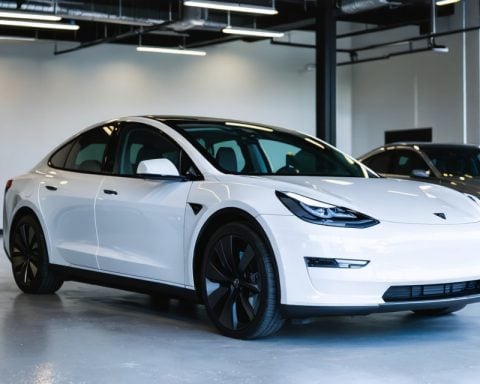- Recent technological advances have helped electric vehicles (EVs) retain 96-97% battery capacity in models from 2019-2023.
- Cold weather can reduce an EV’s range by up to 50% as energy is used to keep batteries and cabins warm.
- Effective strategies like pre-conditioning—warming the cabin and battery while plugged in—can preserve range.
- Parking in the shade and adjusting tire pressure are practical methods to combat weather-induced battery degradation.
- Eco-modes in modern EVs optimize energy efficiency during cold temperatures, aiding in range conservation.
- Mindful management of cabin heating ensures energy resources are not rapidly depleted.
- Understanding and adapting driving habits and vehicle use are crucial for maintaining EV performance and longevity.
Imagine your electric vehicle silently gliding through the crisp morning air, the hum of technology barely audible. Yet beneath the sleek exterior, an evolving battle ensues against the elements. Recent leaps in technology have provided a promising buffer against battery decline, allowing models from 2019 to 2023 to retain an impressive 96-97% of their original capacity. Nevertheless, the forces of nature continue to challenge these resilient powerhouses.
Cold weather, an age-old enemy of the battery, stealthily undermines performance. As temperatures drop, an electric car’s range can diminish by up to 50%, a testament to the energy required to keep both the battery and passengers warm. While drivers of internal combustion engines feel the chill too, it’s the EVs that truly bear the brunt.
Yet, hope glimmers. Simple habits can help extend the life of your EV. Picture pre-conditioning: warming the cabin and battery while still connected to a power source, preserving precious range. Or imagine parking your vehicle in the cool embrace of shade to fend off heat-induced degradation.
Modern electric cars often come equipped with eco-modes, an intuitive response to maximize energy efficiency. When temperatures plunge, these settings can become a driver’s best friend, minimizing range reduction even on those epic winter road trips.
In this battle against time and temperature, every choice counts—even the subtle adjustment of tire pressure to counteract cold’s effects. And, of course, judicious use of that toasty cabin heater ensures you won’t burn through reserves too swiftly.
The key takeaway? The path to longevity lies not in groundbreaking innovations alone but in understanding the nuances of operation. By adopting thoughtful strategies, drivers can navigate the seasons and maintain their EV’s vigor for miles and years to come.
Maximize Your Electric Vehicle’s Performance: Insider Tips You Need to Know
How-To Steps & Life Hacks for Extending EV Battery Life
1. Pre-Conditioning the Vehicle:
– How-To: Before embarking on a journey, use pre-conditioning features to warm up your EV’s battery and cabin while it’s still plugged in. This reduces the drain on the battery when you actually set off.
– Life Hack: Schedule your pre-conditioning via the car’s app or onboard system, so it’s ready when you need it.
2. Smart Parking Choices:
– How-To: Always aim to park your EV in shaded and sheltered areas during extreme temperatures.
– Life Hack: If possible, use a garage or find sheltered parking to protect against both cold and hot weather.
3. Utilize Eco Modes:
– How-To: Engage the eco-mode feature on your EV, especially during long trips in harsh weather conditions. This helps in optimizing battery usage and extending range.
– Life Hack: Familiarize yourself with the eco-mode settings and customize them according to your driving needs.
4. Maintain Optimal Tire Pressure:
– How-To: Regularly check and adjust tire pressure as per manufacturer recommendations, especially before long drives in cold weather.
– Life Hack: Invest in a quality portable tire inflator to keep your tires at optimal pressure anytime and anywhere.
Real-World Use Cases
Examples of Successful Energy Management:
– Nissan Leaf Owners: Many owners report significant range maintenance by adopting these optimization strategies, especially pre-conditioning and smart charging routines.
– Tesla’s User Base: Tesla’s ecosystem and user community often highlight the importance of using Tesla’s advanced scheduling and autopilot features to extend battery life and optimize energy use.
Market Forecasts & Industry Trends
Growth in Battery Technologies:
– Predictions (2023-2030): According to BloombergNEF, the electric vehicle battery market is expected to witness rapid advancements with predictions of 10% annual growth in energy density of EV batteries, leading to longer ranges and shorter charging times.
Software Innovations:
– Trends: More manufacturers are developing predictive software that can further assist in battery management, taking into account driving patterns, weather, and terrain.
Reviews & Comparisons
Performance in Varying Climates:
– Warm vs. Cold Climate: Vehicles from Tesla and Hyundai tend to perform better in colder climates due to effective battery management systems compared to some other models.
Controversies & Limitations
Variability of Range Claims:
– Issue: There’s an ongoing debate about manufacturers’ claimed vs. real-world battery range in varying climates. Consumers are advised to consider user testimonials and independent tests alongside these claims.
Features, Specs & Pricing
Battery Capacity and Pricing:
– Key Models (2023):
– Tesla Model 3: ~75 kWh battery with starting prices around $46,000.
– Nissan Leaf S Plus: ~62 kWh battery with starting prices around $32,000.
Security & Sustainability
Environmental Impact:
– EVs eliminate tailpipe emissions, contributing to cleaner urban air. However, sustainable disposal and recycling of EV batteries remain a concern. Ongoing research in recycling technologies looks promising with improved methods to reclaim valuable materials.
Pros & Cons Overview
Pros:
– Energy-efficient with potential for long-term savings.
– Low emission levels contributing to environmental conservation.
Cons:
– Initial higher purchase cost.
– Infrastructure and charging accessibility vary by region.
Actionable Recommendations
– Immediate Tips: Regularly update your EV’s software to gain access to the latest energy-efficient algorithms.
– Long-Term: Consider investing in a home charging setup if you haven’t already to optimize charging schedules and benefit from lower energy costs during off-peak hours.
For more information on electric vehicles, visit Tesla or Nissan.
By incorporating these strategies and insights, drivers can optimize their electric vehicle’s performance across all seasons. Enjoy the ride!














